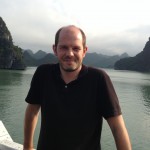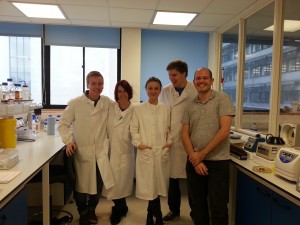by Phil Aldridge
As scientists, it is critically important to prevent ourselves from becoming isolated in our own specialised world , as maybe, just maybe, the best person to help solve the scientific riddle you have been fighting with works just down the corridor. Finding that person is enormously helped by working in a vibrant and open community. This is why, once in a while, coming together with your colleagues to discuss the science we are pursuing is vital. This is something we have always tried to nurture in ICaMB . On a personal note it was one of the key factors that made me decide to accept the offer of the lectureship I interviewed for 10 years ago!
 So, to our ICaMB Away Day held on Monday 14th October 2013 at the Vermont Hotel in downtown Newcastle. A new focus for the event this year was to hear primarily from the post-docs and PhD students about the work they are doing. In addition, we also featured talks from three of our new PIs, Owen Davies, Yulia Yuzenkova, who was recently awarded a Royal Society University Research Fellowship and Bert Van-Den-Berg.
So, to our ICaMB Away Day held on Monday 14th October 2013 at the Vermont Hotel in downtown Newcastle. A new focus for the event this year was to hear primarily from the post-docs and PhD students about the work they are doing. In addition, we also featured talks from three of our new PIs, Owen Davies, Yulia Yuzenkova, who was recently awarded a Royal Society University Research Fellowship and Bert Van-Den-Berg.
A unique aspect of ICaMB is the diversity of the science we do and this is always a major take home message when we get together during our away days. This year, talks ranged from some fascinating work using bioinformatic analysis to interrogate the deep realms of evolution all the way up to the significance of where one little helix fits into a protein structure. Ah the joys of science…
Another way to view our away day is to focus on the range of techniques we all employ. The day was opened by Henrik Strahl* from CBCB, who is doing some elegant work with the super resolution microscope we have housed in the Baddiley-Clark building. Incidentally these microscopes are available for anyone in ICaMB to use and get excited about, not just Henrik.
Sometimes, to get to the bottom of our inquisitiveness, we require some BIG science. During our away day we heard from Simon Cockell, Arnuad Basle and Peter Banks about three opportunities we have in Newcastle to take our science and its analysis to that level using high throughput screening and bioinformatics analysis.
 Arnuad gave a brief overview of how the Structural Biology lab has been coordinating a wide range of projects, with an impressive collaborators slide that was a who’s who of ICaMB.
Arnuad gave a brief overview of how the Structural Biology lab has been coordinating a wide range of projects, with an impressive collaborators slide that was a who’s who of ICaMB.
Simon highlighted three large ICaMB data analysis projects he has been involved in from the Bioinformatic Support Unit. He also used the chance to get rather excited about the recent developments that has allowed the BSU to begin proactive recruitment, to bring in, as he said, “A half a dozen people to do a dozen peoples work, rather than two doing it all”
Peter then introduced the new faculty high-throughput facility that has been developed out of the work he has done with David Lydall. Hearing these talks can stimulate ICaMB members to look for ways to exploit these facilities to benefit their own research – exciting times, if you have the money of course.
 Finally we come to the PhD students. Instead of the typical format of more talks, the organising committee this year invited our students to attempt a format growing in popularity termed “The 3 Minute Thesis.” This was ICaMBs first experience of this, although our colleagues in ICM had introduced it at their away day earlier in the year. Hmm, maybe an opportunity for some friendly cross faculty competition? This format requires a student (or PI) to get across the message of their work in exactly 3 minutes, with the timing being strict and the talker being stopped at exactly 3 minutes. Eight students stood up to the challenge and we experienced a range of approaches to get their points across. Congratulations go out to all eight, especially Daira from Jeremy Lakey’s lab who won the judges approval with her demonstration of colicin action with two balloons, some sticky tape and a scary looking needle.
Finally we come to the PhD students. Instead of the typical format of more talks, the organising committee this year invited our students to attempt a format growing in popularity termed “The 3 Minute Thesis.” This was ICaMBs first experience of this, although our colleagues in ICM had introduced it at their away day earlier in the year. Hmm, maybe an opportunity for some friendly cross faculty competition? This format requires a student (or PI) to get across the message of their work in exactly 3 minutes, with the timing being strict and the talker being stopped at exactly 3 minutes. Eight students stood up to the challenge and we experienced a range of approaches to get their points across. Congratulations go out to all eight, especially Daira from Jeremy Lakey’s lab who won the judges approval with her demonstration of colicin action with two balloons, some sticky tape and a scary looking needle.
So all in all a great and successful day out for ICaMB, we heard some fantastic science, were able to be social and meet each other while discovering that what you really need to know to win the ICaMB quiz is the maiden name of Cheryl Cole. We have to acknowledge the excellent job done by our quizmaster, Harry Gilbert, although we suspect that Anne Robinson’s job is safe for now. A final big thank you must go to the organising committee who coordinated the whole event (the blog team are just reporting what happened). Well done Alison Howard, Dave Bolam, Liz Veal, Adam O’Neil and to our Director Bob Lightowlers.
*Congratulations also to Henrik Strahl, who a couple of days after his talk was awarded a Newcastle Biomedicine Barbour Fellowship



